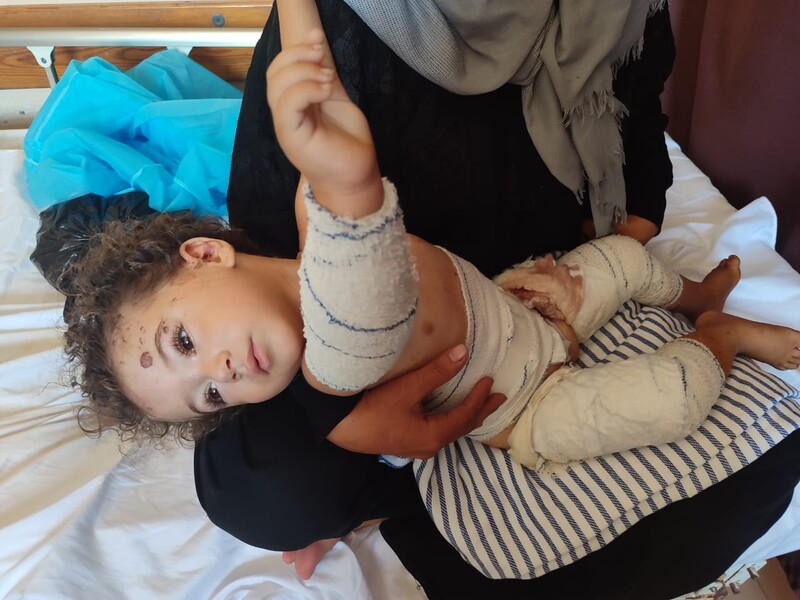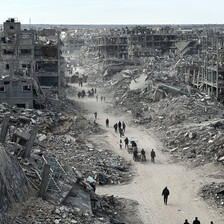The Electronic Intifada 19 July 2024

One of the many children injured in al-Mawasi last Saturday.
Yasmine al-Akkad had given birth a few weeks earlier.
When she heard a loud explosion last Saturday (13 July), Yasmine immediately grabbed her baby. Then she lifted her other daughter – a 2-year-old – and began running through al-Mawasi in southern Gaza.
Yasmine survived the massacre in which more than 90 Palestinians were killed. But she is deeply traumatized by what she witnessed.
“The worst thing I saw was the body of my brother-in-law on a tree,” she said. “It was cut in two.”
A child named Abd al-Rahman was hungry.
His mother was unable to cook anything for him. So she had told him to head for a communal kitchen in al-Mawasi, where food was being distributed.
Abd al-Rahman is still alive after the massacre – though he required an amputation.
Many others who had joined him in the queue for food were killed.
A mother was preparing food for her children, when suddenly she heard explosions.
“Everything went black,” she said. “I could not see anything because there was so much smoke and dust.”
There were more explosions. The woman began screaming and searching for her family.
First, she found the body of her baby niece.
All around the area where she was living in a tent, the woman saw numerous dead bodies.
The woman went searching for her husband and her two children, aged 7 and 9. She was not able to find them.
She assumes they have been killed.
“What did these hungry children do to be killed in such a brutal way?” the woman asked.
“Earthquake”
Maha Ahmad described Israel’s bombardment as so heavy that “the area shook like there had been an earthquake.”
Many of the dead were in so many pieces that their surviving relatives either could not identify them or had trouble doing so.
Maha’s home in the city of Khan Younis has been destroyed during the current genocidal war.
She had been displaced to Rafah, Gaza’s southernmost city. When Israel undertook a ground invasion of Rafah in May, it designated al-Mawasi a “safe zone.”
“The whole world began to know al-Mawasi as a safe area but unfortunately it isn’t,” Maha added. “It has become the most dangerous area for the displaced.”
Rami Labda was searching for water in al-Mawasi on Saturday when Israel’s attack began.
He rushed to check on his family’s tent and was reassured that it was empty. His family had planned a trip to the sea that day.
People in nearby tents had not been spared.
“I found three of my neighbors injured and another one killed,” Rami said.
Amal Akar was displaced from an area east of Khan Younis to al-Mawasi a few weeks ago.
On Saturday, her nephew Fayez had gone shopping when Israel attacked.
“Everyone started phoning to check on him,” Amal said. “But he did not reply.”
After approximately an hour, Amal heard that Fayez had been injured. She and others in the family went to look for him at Nasser Medical Complex in Khan Younis.
“The scene there was frightening,” she said. “There were mothers screaming and doctors running around, trying to save the patients.”
Amal learned that Fayez had been bleeding heavily. A doctor was attending to him when he died.
“It was a great shock,” she said. “We have now lost more than 10 people in our [extended] family since the beginning of this war.”
“The repeated targeting of al-Mawasi is frightening all the displaced people there,” she added.
“People want to leave the area but they cannot find other places to go. There has been huge destruction in all areas of Gaza.”
Fedaa al-Qedra and Ruwaida Amer are journalists based in Gaza.





